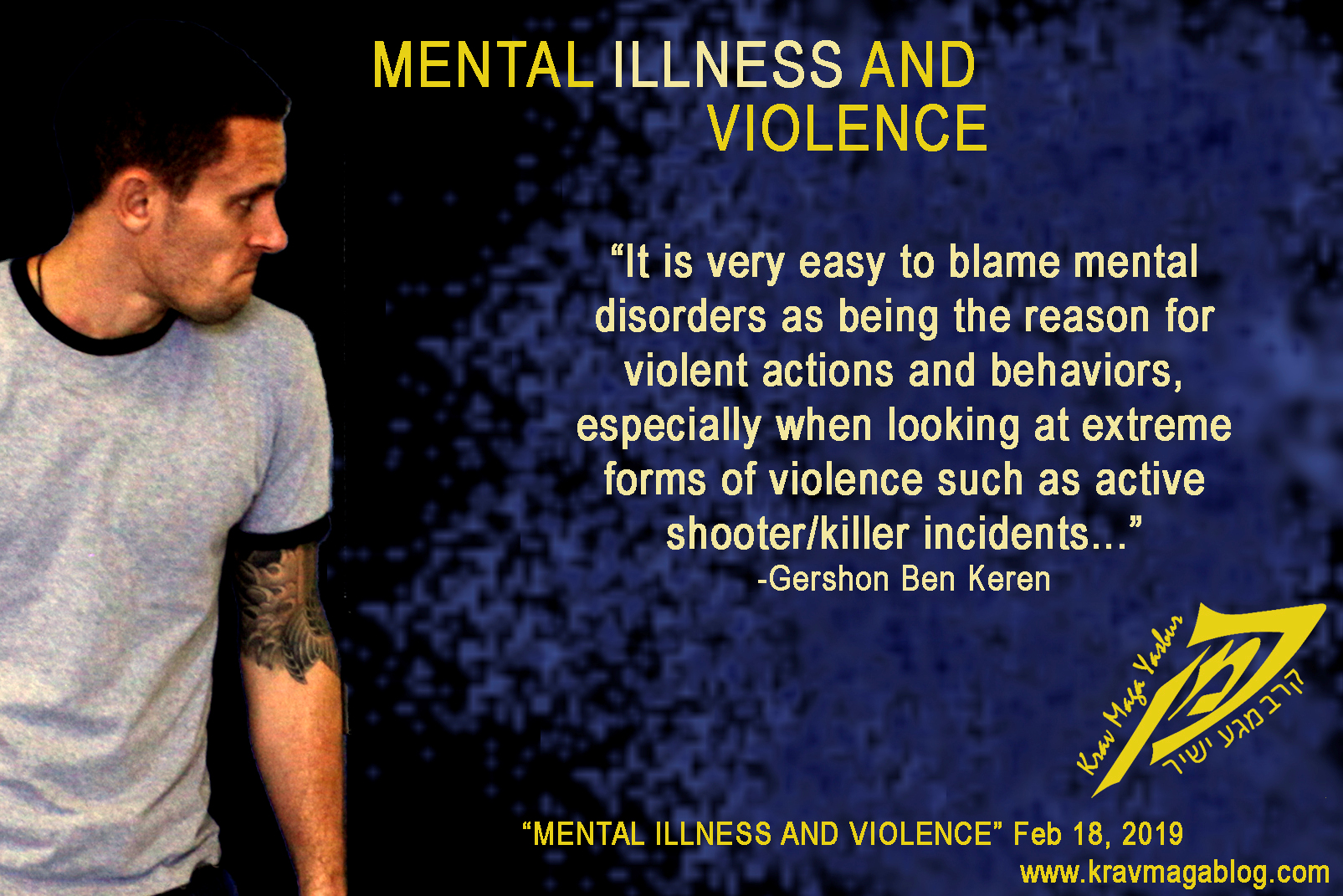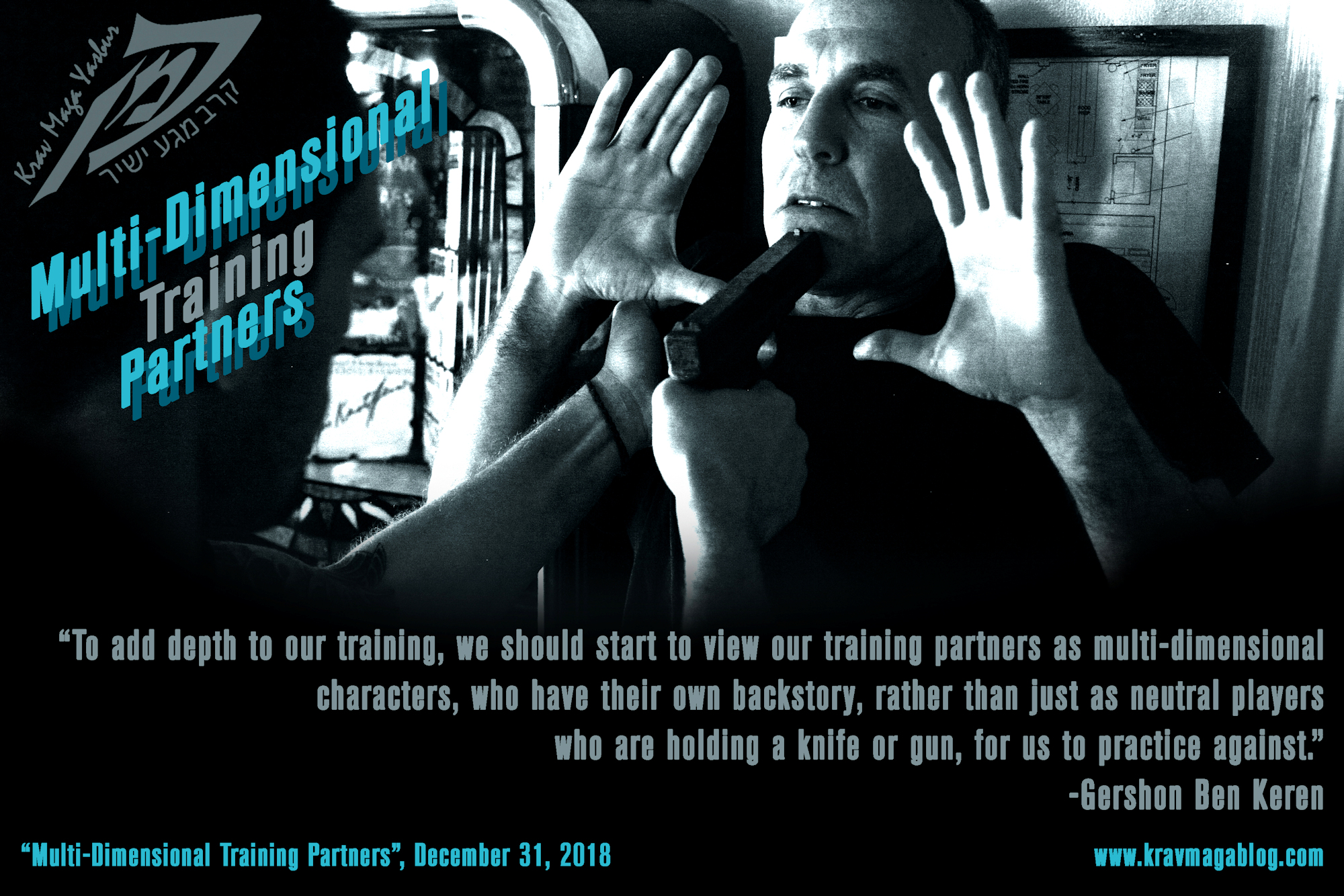Multi-Dimensional Training Partners, is an article written by Gershon Ben Keren, a 5th Degree Black Belt in Krav Maga, who teaches Krav Maga in Boston, MA. He has also authored three Amazon best-Selling Books on Krav Maga.
Violence in self-defense, is often sanitized and/or romanticized; with the attacker being presented as a neutral player, who is simply going through the motions of an assault. Leaving out the “why” of violence and failing to consider the potential complexity of motive has significant consequences for self-defense and scenario-based training. A mugger doesn’t simply want your wallet/money, they want it for a reason e.g. to support a drug habit, to support themselves and/or their family, etc. Whilst we will not necessarily be able to determine the “backstory” (or involvement decisions) of every aggressor, we have to acknowledge that they have one, and it is this which has brought them to this moment in time – as well as coloring how they view us e.g. are we an object for them to use, a vehicle through which they can express their anger (or a need to demonstrate power and control), or a person with whom they want to interact, albeit through exploratory violence? There is a huge difference between dealing with a threat and dealing with an attack. If somebody is trying to cut, stab, or slash you, considering motive is a distraction; however if they are showing you a knife and making demands of you, acknowledging and recognizing motive will help you determine an effective solution. If you will always go physical, when faced with a threat, you may be putting yourself in unnecessary danger – and it may be that by not considering the motive, and profile of the attacker, you will find that your solutions will be ineffective e.g. most armed robbers/muggers are drugged or drunk when committing their offenses, and so may be pain tolerant to solutions that rely on striking/punching, etc. When we sterilize violence, taking the individuality of the attacker out of the equation, we may be creating solutions that have limited applicability in real life.
There is a danger in treating motive(s) as something that develops through a rational, conscious process, and criminal and violent acts, as calculated affairs, where the individual carefully weighs up the consequences of their actions e.g. when somebody points a gun at you, and demands your wallet, all they are thinking about is the wallet; your actions and behaviors will determine their next step, there isn’t a well-structured and organized plan, which has been created considering responses to all possible outcomes, etc. A hesitation on your part to comply, may be interpreted as a refusal to obey their demand(s) – which may be motivated by a need to get money for their next fix, or to pay for drugs/medicine for a sick child, etc. In that moment, an association has been made between your compliance/non-compliance and the “need” that it will, or will not, fulfill. In this moment your wallet/money is far more important to them than it is to you – unless you are living a similar lifestyle. I was recently reading the account of a UK mugger who made the decision to engage in armed robbery, after he and his wife had to clean up themselves and their baby, who had a stomach infection, by candlelight, because the credit on their electricity meter had ran out, and they had no money to feed it. I’m not sharing this in attempt to gain sympathy for those who engage in violent crimes, but to illustrate the level of desperation that somebody committing such a crime may be experiencing, and that this shouldn’t ever be underestimated. If a robbery seems to move – for any reason – outside of such a mugger’s control we should expect them to respond with extreme violence, rather than with a “measured” response. To add depth to our training, we should start to view our training partners, as multi-dimensional characters, who have their own backstory, rather than just as neutral players who are holding a knife or gun, for us to practice against.
In acts of spontaneous – rather than premeditated – violence, we should also recognize that although somebody may not have planned, or even looked to take advantage of an opportunity, for violence, they may be predisposed to using violence, either as a form of expression, or as an instrumental means to accomplishing a goal; I have dealt with individuals who lacked the basic social skills to resolve conflicts via dialogue, and so use physical violence instead. This is a real issue when somebody has a weapon on them; which in certain circumstances can be an indication of a risk-seeking lifestyle i.e. a predisposition, rather than a premeditation, for the use of violence - they acquired and carry a weapon due to the anticipation of violence, which is often based on past experiences and interactions they’ve had. These experiences form their “backstories” and need to be taken into account when dealing with incidents of spontaneous social violence. Three assumptions I make when dealing with any aggressor, is that they are armed, assisted, and able; that is, they have the means to handle themselves in the situation, even if there is a differential between our skills and abilities in my favor; aggression, prior experiences of violence, and commitment can go a long way in a fight and are capable of dismantling even the most practiced and proven techniques. What may be seen as an overreaction to a minor slight, such as knocking into somebody, jumping ahead in a queue/line, can be an indication of a person’s prior experiences of dealing with conflict, and if they are still using aggression/violence to settle disputes, it’s a fair guess that this has worked for them enough times in the past. It may be that where violence is concerned your history and experience is secondary to theirs – either time to “walk away” or take the initiative away from them e.g. by going pre-emptive. We shouldn’t simply practice engagement in our training, but how to disengage safely (even if our ego does take a dent in the process).
Our training partner should be seen as something more than just a person to train with; they should be visualized and interacted with, as someone with a “story”, that explains why they are acting and behaving the way they are. This will also help make sense of certain techniques and explain the contexts when certain attacks occur. How many times have you practiced a defense against a rear-strangle, without considering why, and to what purpose, somebody would make this kind of attack? What’s the motive, and what is their backstory that created and developed this motive? Violence isn’t simply a “thing”, it’s an interaction with a purpose, and it is only by trying to understand this that we will start to train effectively and realistically.
0 COMMENTS













